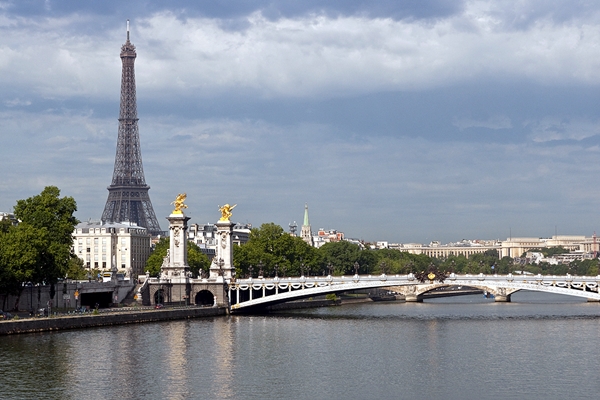
Paris, France
One surprising discovery he has made is that it’s possible to visit Europe without ever boarding a plane or stowing away on a steamer ship.
Dr. George Freundlich, a retired medical doctor and career musician, is an avid traveler, having visited over 100 countries. He enjoys immersing himself in diverse cultures and collecting stories, memories, and vignettes along the way.
One surprising discovery he has made is that it’s possible to visit Europe without ever boarding a plane or stowing away on a steamer ship. He discovered that Canada and France were not just friends, but actual neighbours as well!
The Matheson, Ontario doctor isn’t referring to a day trip to Quebec, where of course the vibrant culture of France lives on. Rather, he is talking about land ruled by France that is located south of Newfoundland. It turns out the European Union borders Canada and the U.S.
Originally from Romania, Dr. Freundlich is the former Medical Director, Chief of Staff, and Active Staff Emeritus at the Bingham Memorial Hospital. In 2008, he was Canada’s Physician of the Year. He has lived in Canada for nearly four decades in Ontario, Quebec, Newfoundland and Labrador, as well as New Brunswick.
Many know that France still maintains several territories across the globe, including French Polynesia in the South Pacific, St. Martin, Guadeloupe, Martinique, St. Barts in the Caribbean, Reunion Islands in the Indian Ocean, and French Guiana in South America.
However, few people know that only 22 kilometers south of Newfoundland are three islands that belong to France. Of the three, only two are inhabited: St. Pierre and Miquelon. These inhabitants are all French citizens, including members of the EU.
During his time working as a doctor in Newfoundland and Labrador, Dr. Freundlich had the opportunity to visit these islands several times. In early 1993, Dr. Freundlich worked In St. John’s at The Health Science Centre Memorial University of Newfoundland. In his experience, very few people in Newfoundland spoke the French language.
Fortunately for hundreds of patients, Dr. Freundlich spoke French very well, leading to a conversation with Robert Williamson, who was the Minister of Health at the time. All of the patients from St. Pierre and Miquelon Islands who couldn’t be treated appropriately at their own local hospital were sent by plane to Newfoundland’s capital, St. John’s. As virtually no one in the medical community could speak French, and the population of St. Pierre and Miquelon typically didn’t speak English, there were serious communication issues.
As a result, Williamson asked Dr. Freundlich to make himself available for the five hospitals in St. John’s for any situation in which a patient was urgently brought from St. Pierre and Miquelon. This required the good doctor to effectively work seven days a week for an indefinite period of time.
One night in February, in 1993, At Janeway Children’s Hospital, Dr. Freundlich would encounter a very ill 4-year-old girl named Aurelie, who had been transported from St. Pierre. She looked extremely ill. She was complaining of extremely severe, recurrent abdominal pain, nausea, vomiting, chills, and fever. She had been assessed by several doctors in St. Pierre, but no one could figure out what the cause of her illness was. The doctors wisely decided to immediately evacuate the child by plane to St. John’s, Newfoundland. Doctor George performed a painstaking evaluation of Aurelie and following stat blood work and abdominal US (ultrasound) figured out that this four-year-old girl had gallstones, something unheard of at such a young age. He managed to improve overnight her biological/biochemical parameters and thus made her suitable for emergency surgery. The child underwent top-quality, life-saving surgery and made an excellent recovery.
For his extraordinary efforts, Dr. Freundlich was invited to visit the girl’s family by her father Yannick, who also happened to be the mayor of Saint Pierre and Miquelon. He agreed, and Dr. Freundlich would have the opportunity to see just how much the islands resembled France, from infrastructure to language, and even the food.
While everything there seemed like home to the locals, the experience would be completely foreign to a Newfoundland native. Dr. Freundlich had the opportunity to visit the local hospital, which he noted was very well-equipped. However, the city at the time had just 6,500 inhabitants, making it impractical to build a hospital with all medical-surgical specialties. This is why France has long agreed to pay for the cost of treatment in Newfoundland for the sick in St. Pierre and Miquelon.
After the ordeal, Aurelie’s father realized that it would be very helpful to the wider population to learn English, and he expressed this opinion publicly, receiving an overwhelmingly positive response.
In the end, Dr. Freundlich had not only discovered “Little France” on the islands of St. Pierre and Miquelon, but through his dedication, compassion and medical skill was able to do something historic: enhance communication between two distinct cultures, bringing them closer together as true neighbors.


























































































































































































